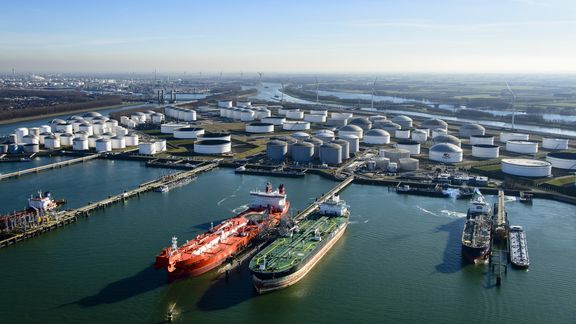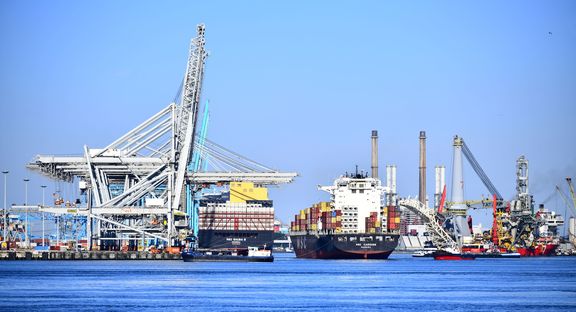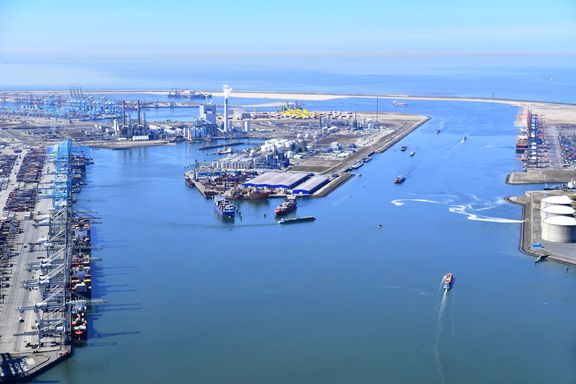Total throughput slightly higher despite declining trade with Russia
The volume of total cargo throughput in the port of Rotterdam was 0.8% higher in the first half of the year (233.5 million tonnes) than in the same period in 2021 (231.6 million tonnes). In many segments, the war in Ukraine led to significant changes. For example, imports of both LNG and coal rose very sharply as an alternative to reduced European imports of Russian gas by pipeline. The throughput of crude oil increased, with oil products falling off. Throughput of iron ore, agricultural bulk and containers was lower than in the same period last year.
Container transport to and from Russia has come to a halt, and persistent bottlenecks in global container logistics caused cargo to shift from large to smaller container ports. In anticipation of the sanctions on coal and oil, less Russian coal, crude oil, oil products and LNG were imported in recent months. Companies are increasingly importing from other countries.
Highlights of the first half of the year
- 0.8% more cargo than in first half of 2021
- Russia: container volume halted, declining volume of coal, LNG and oil
- Increase in revenue and operating result of the Port Authority
- Energy transition: investment decisions by business approx. € 3 billion
- Solution for nitrogen issue still a pressing concern
Allard Castelein, CEO Port of Rotterdam Authority: 'Europe relies heavily on Russian energy. The current geopolitical situation makes Europe very vulnerable. The availability of energy and raw materials at reasonable prices cannot be taken for granted. A positive development is that concrete steps have been taken in recent months to make our energy supply more sustainable and to further our energy independence, particularly through investment decisions to build a large biorefinery and Europe’s largest green-hydrogen plant. The business community has made a commitment in the last half year to invest € 3 billion in the energy transition. In addition to the vulnerability of the European energy system, nitrogen emissions continue to be a major bottleneck. Several major projects, including the CO2 capture and storage project Porthos, are being delayed or threatened by delays due to uncertainty and restrictions associated with nitrogen emission'.
The Port Authority had a good first half of the year financially. Revenue increased by 6.3% (€ 24.6 million) to € 412.2 million and operating expenses decreased by 2.4% (€ 3.1 million), mainly due to lower expenditure on sand extraction. Gross investments in the first half of 2022 amounted to € 117.1 million, including capital injections in participating interests (first half of 2021: € 100.5 million). The most important investments for the first half of 2022 were the construction of quay walls in the Amaliahaven and the land reclamation operation in the Alexiahaven on Maasvlakte 2.
Vivienne de Leeuw, CFO Port of Rotterdam Authority: 'Our robust financial position is essential to continue investing in traditional hardware such as quay walls and jetties in the years ahead, but particularly in infrastructure for the energy transition. In addition, we are continuing to invest in digitalisation. By maintaining our position as a port with world-class infrastructure, we are ensuring that we remain an attractive location for companies to invest in the transition'.
Safety and security
Safety and security are a top priority in the port of Rotterdam. The Port of Rotterdam Authority works hard with public partners to maintain safety and security, both on the water and on land. Unfortunately, in the first half of the year, there was a very serious accident involving an inland vessel. There were no major environmental incidents. The Port Authority is committed to improving the digital security of systems and the cyber resilience of businesses and employees. Subversion and drugs crime constitute an increasing problem in the port of Rotterdam. Here also, the Port Authority plays a role, for example by making its own employees and companies in the port aware of integrity through the ‘Port Integrity’ programme. In addition, agreements were made with the partners and the Ministry of Justice and Security to extend and further develop the existing network of 225 cameras in the port. The images from this network are viewed by a range of public partners (Harbour Master’s Division, police and customs).
Dry bulk
The dry bulk segment saw an increase of 4.4% in the first half of the year. The throughput of agricultural bulk was down by 15.1%. This segment is always heavily influenced by the size of harvests in different parts of the world. In addition, there were strikes at one of the processing companies. Another factor was that less agricultural bulk was processed because of high energy costs. High energy costs also led to lower production by the German steel industry and, as a result, a fall of 20.6% in iron ore imports. The imports of cokes for the steel industry remained at the same level. Coal throughput for electricity plants rose sharply. On balance, this resulted in a 29.7% increase in coal throughput. Coal is currently cheaper than natural gas and it also reduces dependence on Russian natural gas. The 30.1% increase in other dry bulk is striking. It is primarily attributable to the high prices for the shipping of containers: cargo that can also be transported in bulk, such as industrial minerals and fertilisers, is therefore being transported in this way more often.

Liquid bulk
In the first half of the year, the transport of liquid bulk rose by 4.6%. The 4.3% increase in crude oil was mainly caused by the flow of Russian oil through Rotterdam to India in particular. Refineries in Northwest Europe are switching to non-Russian oil, with the result that Russian oil is finding its way to other markets. The 9.4% decline in the throughput of oil products is mainly due to the structural decline in the imports and re-exports of fuel oil. LNG rose by 45.8%. There is very strong demand for LNG as an alternative to the natural gas entering Europe by pipeline from Russia. The 22.5% increase in other liquid bulk goods can be attributed, on the one hand, to a shift from transport in tank containers to chemical tankers and, on the other, to stockpiling by purchasers of chemical substances. In the light of faltering transport chains, they are doing this to make sure they have adequate supplies of raw materials.
It was possible to see a shift in the origin of imports of coal, crude oil, oil products and LNG in the second quarter. Companies are sourcing these energy carriers and raw materials less and less from Russia and purchasing them elsewhere in the world.
Containers and breakbulk
The throughput of containers was down 4.4% (in TEUs, the standard unit for containers). The decrease was 8.9% in terms of weight. The difference between the two is attributable to an increase in the number of empty containers. There are two principal reasons for the decline in container throughput. The first is the loss of container traffic to and from Russia due to the sanctions, the uncertainty associated with the continuation of trade with Russian parties, and the discontinuation of scheduled services to Russia. The second is the ongoing disruption of container logistics. Two years ago, the COVID-19 pandemic led to lockdowns and changes in consumption patterns. Container vessels were no longer able to comply with their sailing schedules, with disruptions in pre- and post-transportation as a result. To make up time, large vessels are now often cancelling calls to ports in their itineraries (-5.5% calls in Rotterdam by comparison with last year), and loading and unloading more containers per call (+6.1%). This results in peaks in activity at the terminals, which were already very busy since containers are left there for longer times on average because ship arrival times are more unreliable. As a result of these developments, shipping companies are currently using smaller ports of call for transhipment relatively more often than large ports such as Rotterdam. A chain consultation platform was established to monitor developments with all players in the Rotterdam container sector and to respond in the best possible way.
Roll-on/roll-off traffic rose by 16.8%. This figure paints a rosy picture because of the end of the Brexit transition period on 1 January 2021. At the time, that led to additional transport in late 2020 and a dip in RO-RO transport in early 2021.
Other break bulk rose sharply by 17.7%. A major factor consisted of imports of steel and non-ferrous metals. In response to the Russian invasion of Ukraine, steel and non-ferrous prices shot up. Alternative suppliers were soon found, particularly from Asia, where COVID-19 actually led to a slump in demand for steel. Imports of steel and non-ferrous metal therefore increased. In addition, high container rates mean that more cargo is being shipped as break bulk.

Finances of the Port of Rotterdam Authority
The revenue of the Port of Rotterdam Authority in the first half of 2021 rose by € 24.6 million compared with the first half of 2021 to € 412.2 million. The increase in port dues accounted for € 16.1 million. This increase is primarily attributable to a higher number of vessels, resulting in a higher price per throughput tonne. The increase in revenue from rental contracts of € 6.2 million is mainly due to contractual indexation.
Operating expenses fell by 2.4% (€ 3.1 million) in the first half of 2022 to € 124.4 million. In particular, the cost of sand extraction fell with the switch to a new concession party in 2022.
Investments, including capital injections in participating interests, amounted to € 117.1 million. The most important investments for the first half of 2022 were the construction of quay walls in the Amaliahaven (€ 32.7 million) and the land reclamation operation on Maasvlakte 2 (€ 19.8 million). In June 2022, the dividend including dividend tax of € 122.7 million for the financial year 2021 was paid to the City of Rotterdam and the Dutch State.
Digitalisation
Data sharing and the digitalisation of processes are the key to solving the most common challenges in logistics. The Port Authority is therefore investing in the development of digital tools and programmes. All inland shipping, rail and short-sea operators in Northwest Europe are now connected to the planning tool Routescanner, as are several deep-sea shipping companies. They share their sailing and driving itineraries directly on the Routescanner platform, and this platform is therefore well on its way to becoming the global, neutral location for displaying container routes. Since the platform went live in October, 15,000 inland shipping calls have been scheduled using the Nextlogic planning tool. With players in the logistics chain, we are working on implementing integrated planning at the Port of Rotterdam and connecting new parties. In addition to investing in digital platforms to improve the logistics chains through Rotterdam, we are also investing in data solutions to optimise the infrastructure in the port. For example, a new data platform for earth-retaining structures is being developed with Delft University of Technology.
Progress on the energy transition
Large projects involve long preparation times. A large portfolio of projects for the energy transition has been built up in recent years. Now that it is gradually becoming clearer how the abstract climate goals will take shape in concrete European and national policy and regulations, it is becoming increasingly clear how this will affect the various projects. A number of important investment decisions were made in the past six months, the most significant being those for a major biorefinery and Europe’s largest green-hydrogen plant. In addition, companies have made a definitive decision to expand an ammonia import terminal, increase battery recycling capacity, build a hydrogen refuelling station for trucks and implement a shore power project. These investment decisions by the business community add up to a total amount of approx. € 3 billion. This kind of investment means that the energy transition is progressing across the entire spectrum. In addition, the Port Authority decided in this half year to accelerate the reduction of its own organisation’s carbon emissions. The goal is to reduce our own carbon emissions by 75% by 2025 and 90% by 2030 compared with 2019.
Nitrogen emissions issue slows down transition
A major concern is that, three years after the Dutch Council of State’s ruling on nitrogen deposition, uncertainty persists about rules such as the ‘construction exemption’ and there are still restrictions associated with nitrogen emissions. This can act as an obstacle to the energy transition, even though projects of this kind often result not only in lower carbon emissions but also to lower emissions of nitrogen and other substances, in Rotterdam or elsewhere in the chain. It should be pointed out that industry in Rotterdam accounts for only 1% of nitrogen deposition in vulnerable Dutch nature areas.

Outlook
The current geopolitical situation is generating numerous uncertainties. Reliable energy supplies in Northwest Europe can certainly not be taken for granted. Energy prices are high, and this is a major factor in the sharp rise in inflation. A recession may follow. This makes forecasting throughput volumes for the second half of the year very difficult. In the energy transition, which is so important for the future of the port and for achieving the national climate goals, the required measures are again expected to emerge in the second half of the year. Solving the nitrogen problem is very important if we are to continue to make progress.